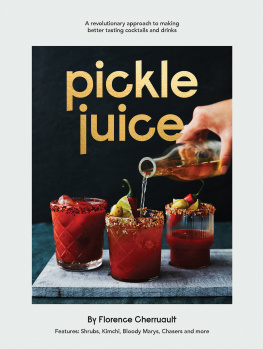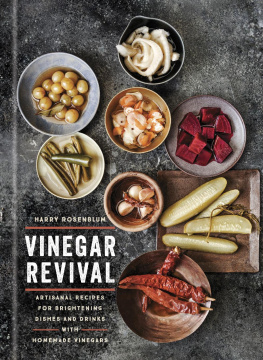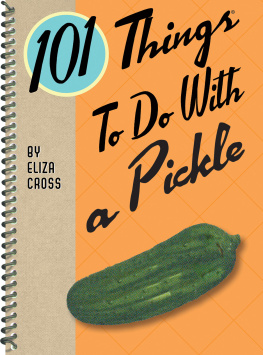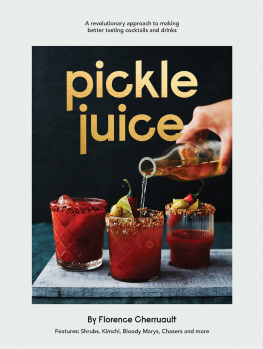Contents
Pickling and concocting has become somewhat the norm in my day-to-day life. Theres always an array of things pickling in jars on the kitchen counter, and bowls of different fruits and herbs macerating in our conservatory at the back of the house to keep them cool. Friends often joke its like theyre in a school science lab as I emerge with different concoctions for them to try. This book brings together my experiments in the world of pickling with the knowledge of bartenders and mixologists to create a collection of recipes for pickle juices, drinking vinegars and cocktails both alcoholic and non-alcoholic. Florence Cherruault Ive always loved the sharp, briny taste of pickles. Theres something about the vinegary tang that makes eating them a bit of a challenge, but its oh so worth it.
My absolute favourites are the little cornichons you get in French supermarkets, but a packet of pickled onion Monster Munch is always my go-to for that morning after the night before feeling. It was while on holiday in New York that I first tried a Pickleback. The idea of throwing back a shot of whisky followed by a shot of pickle juice seemed like a strange one, but my boyfriend insisted I give it a go I was hooked. Once back in London, I started experimenting with different recipes, aiming to create a pickle juice perfect for drinking; one that would go way beyond the leftover brine found at the bottom of a jar of pickles. After many months developing the recipe, I came up with a blend of sliced cucumbers and spices that I brewed for around 12 weeks to create a sweet-and-savoury flavour that packs a real punch. In 2014, I decided to launch The Pickle House and sell my Original Pickle Juice.
The first batch made 10 bottles, so I decided to go to 10 different bars around London to see what they thought. I started off at Oslo, which had just opened in Hackney Central. The bar manager ordered 40 bottles for that weekend. I was so excited that it took me a second to realise there was no way I could fulfill his order in time. Thankfully, he was happy to wait. As with any strong-flavoured product, like Marmite, for example, some people loved the pickle juice and some werent so keen, but once a few bartenders were on board with it, they started coming up with some great pickle-based cocktails.
One drink they all loved was the Bloody Mary, which led me to launch my Bloody Mary Mix: a blend of tomato juice, fresh horseradish, spices and pickle juice. I never would have thought that when I grew up Id be making pickle juice, but here I am!
Pickling and shrub-making are similar in that both methods were used to preserve surplus fruit and vegetables prior to the invention of refrigerators. Pickling has been around for a long time and has been said to date way back to 2,400 BC, whereas shrubs are said to have originated in 17th-century England. The main difference between the two is that pickles are usually savoury and tend to use vegetables pickled in a salty, vinegary brine. Shrubs are the sweeter version, using predominantly fruits (and some vegetables) macerated in sugar to create a sweet, vinegary syrup. It was a couple of months after launching my Original Pickle Juice that I discovered all the health benefits.
Apple cider vinegar with the mother has been used for centuries as a natural health remedy to fight coughs and colds. The mother looks like a cloudy substance that sits at the bottom of the bottle and, much like a SCOBY (symbiotic culture of bacteria and yeast) in kombucha, its full of good bacteria along with acetic acid and natural protein, which is great for your health. Drinking vinegar, be it in pickle juice or a shrub, can help improve digestion, lower blood-sugar levels, support your immune system and, seriously, the list goes on! Its also meant to be great for your skin and nails. The pickle juice recipes in this book include apple cider vinegar and salt, packing them full of electrolytes ideal for rehydrating your body, whether youre suffering from a hangover or post-workout cramps. Some of the recipes call for turmeric which, like apple cider vinegar, has a huge list of health and medicinal benefits thanks to its anti-inflammatory and antioxidant properties. Although I first discovered the idea of drinking pickle juice in the form of a Pickleback in New York in 2013, I know its been around a lot longer.
Many have claimed they discovered the Pickleback, but, having spoken to a lot of Pickleback connoisseurs, most seem to agree that it was a guy called Reggie Cunningham from the Bushwick Country Club in New York. That said, I remember taking a bottle of pickle juice to a friends house a few years ago and her mum was so excited. She began telling me how, growing up in Poland, they would have shots of vodka then eat pickles and sip on the leftover brine from the bowl. Its hard to pinpoint exactly when pickle juice and shrubs started being used in cocktails, but the idea of drinking vinegar to aid weight loss has been around for decades. It is believed to help suppress your appetite and make you feel fuller for longer. I cant back that with any personal proof, but I can say that adding pickle juice and shrubs to cocktails is delicious.
Each add a rich, umami flavour that is different to any other drink youll find on a menu; the vinegar adds a depth of flavour that works so well in both alcoholic and nonalcoholic cocktails. Whats the difference between picking and fermenting? The age-old question, I get asked this constantly! Pickling and fermenting are similar in the idea that both methods are used to naturally preserve foods and the final results have a slightly sharp, tangy flavour. The main difference is that the sharp, tangy flavour found in pickling comes from using vinegar or another acidic liquid. Whereas with fermenting, the flavour comes from a chemical reaction between the sugars found in food and naturally present bacteria. The bit that makes it slightly confusing is that some pickles can be fermented and some fermented foods can be pickled. To compare the two in a bit more detail; when it comes to pickling, although youre using vinegar, which is a product of fermentation, the pickling juice is brought to the boil to allow the salt and sugar to dissolve, which in effect ends up killing and stopping the growth of any microorganisms.
Therefore, pickling doesnt have the same probiotic qualities that fermented foods have. When it comes to fermentation, I spoke to the good guys down at Jarr Kombucha, in London, to find out what their definition of fermenting is. They said in its simplest form, its the breakdown of a substance by bacteria, yeast or other living microorganisms. Basically, when fruits or vegetables are left in an airtight container their natural bacteria begin to break down the sugars found in these foods and converts them into an acid. This process is called lacto-fermentation and is what gives fermented food its sharp, tangy flavour, whilst also creating probiotics, which are really good for your digestion. Examples of fermented foods and drinks are kombucha, , yoghurt, sauerkraut and miso.












